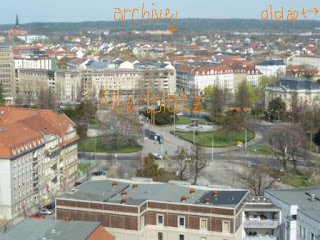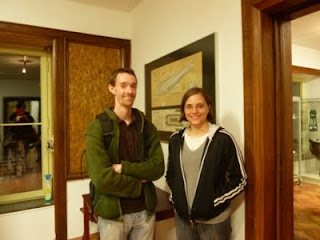Like Mr. Steves (and my paternal grandmother), I like to plan trips. I like to see some of the most important sites, get some local flavor, and do so efficiently and cheaply. But things don’t always go as planned. Sometimes things still turn out great, and other times you are just disappointed. There was a little of both in Dear Husband’s (DH) recent trip to visit Bach me here in Leipzig.
 |
| As if he had just played a concert at the Mendelssohn Haus |
The day he arrived the library where I’m researching was closed for a special occasion, so I was able to meet him in the afternoon without guilt about what I wasn’t getting done work-wise. We had a lovely time at the museum in the house where Felix Mendelssohn Batholdy lived (and died—of a stroke brought on by over-work and exhaustion—eek!). But the first two neighborhood restaurants we tried were closed (despite the signs on their doors indicating they should be open), so we ended up sitting outside and eating at the pub down the street. That day was redeemed.
I was able to arrange for DH to practice on the small grand piano in the seminar room of my apartment building while I was at the library during the week. After two months of his own stuffed-to-the-seams schedule of rehearsals and concerts for Easter and the end of the semester, DH was glad to get the chance to “do his own thing.” We spent the evenings and the weekend together. Saturday we ran errands, did chores, and then explored the permanent exhibit at the Zeitgeschichtliches Museum (Museum of Contemporary History) about life in East Germany. Happily, it was free. Cut to a scene of us enjoying a really delicious meal at a Chinese restaurant just across Lene Voigt Park from my apartment.
Sunday we went to the morning service at the Thomaskirche, Johann Sebastian Bach’s favorite church.*
The theme of the hour and a half-long service was baptism. Four children were baptized, and the children who had been baptized the previous three months also came forward to light their baptismal candles in remembrance/renewal of theirs. St. T seems to do a brisk business in “fire insurance,” because there was quite the parade when they read the roll of names! I thought it was very mete that although a pillar blocked our view of the main chancel area where the baptisms took place, we could see a Renaissance painting of Jesus’ own baptism by John. (Later I learned that the pews at St. T used to face each other across the main aisle, so that pillar would have been less of an obstruction.)
After the main service, Holy Communion was celebrated up in the chancel. The much smaller congregation sat in two double rows facing each other—over Bach’s grave! Well, over his reburial vault, any way. He was originally buried in the New Cemetary of St. John Church, which lies outside the Altstadt on the route to my apartment. But when that church was torn down to put up some apartment buildings, they did a search for Bach’s grave (supposedly “six steps from the door of St. John Church”), found remains of an oak coffin of the kind used for important people, a thimble (from his second wife, Anna Magedelena?), and a belt buckle (from the belt used to secure his burial shroud?). These relics were put in a glass container and can now be seen in the Treasure Room of the Bach Museum!
 |
| Yours truly with the Diamond Fahrrad (manufactured in Karl-Marx-Stadt!) on the Augustusplatz, site of effective peaceful protests against the regime in 1989. |
Since we had eaten lunch with the St. T congregation, we were then free to go on an excursion I had planned for us outside of the city. Here is where a dirctor would have been handy. During the Museumsnacht I had picked up the first edition of a biannual newspaper Leipzig’s museums have put together and became morbidly curious about the Sanitäts- und Lazarettmuseum, which advertised itself with a photo of an exhibit of a field hospital tent (from the Napoleonic Wars), complete with a soldier who had just had his arm amputated. Blood and guts and gore! And if we could figure out how to get all the way out there (open only 1-5pm Sunday afternoons), it might be fun to picnic when we were done. The first bad sign was that their website gave only meager instructions on how to get there; this was followed quickly by error messages from the public transit website. Using Google Maps and downloaded copies of the tram and bus timetables, however, I had finally been able to piece together a half-hour travel plan of a tram and a bus plus some walking at the end. Although the weather was a tad cool and called for possible showers, we had enough time after the Bach Museum to give it a try.
After a full sprint in front of traffic, we were able to catch the tram. 15 minutes later we got off at the end stop and looked around (as it started to sprinkle) for the bus stop. A kindly old man pointed it out to us just as I realized that we had bought tickets for only one transit zone but would be crossing into another zone. But the bus was rounding the corner, so off we sprinted again. The bus driver waved us on. After a few stops, I thought I should either check the map on the bus or else ask the bus driver to confirm the stop we wanted. I possessed the vocabulary to ask, so I did. To my surprise, he told us we should get off right there and take a certain street and then ask for further directions. So we gathered up our stuff, got off (in the light rain), and set out. Five to ten minutes later without any signs of/for the museum, and having already asked one unknowing couple, I realized I had both the museum’s phone number and my cell phone. No answer (whoops—that was the Schumann Museum!). Still no answer; call back during the week said the answering machine. During the few hours of the week that they were supposed to be open!
We consulted a map I had and determined we should have kept going on the bus after all. Back at the bus stop, it looked like another bus was coming in just 10 minutes, so we hung around, hoping to succeed the second time around. But when I asked this bus driver about the whole two zone-thing, it turned out his route ended soon. He got off the bus to show us the time table for the bus we really wanted and explained repeatedly that we wanted the other bus that came in half an hour, until I finally cut him off (“Thank you, I understand!”). At this point he went on his way, and we decided to bag the excursion, since we would have had only an hour at the museum (IF we had managed to find it), and it was no weather for a picnic anyway. So we ran to catch the bus in the other direction—and the first bus driver was driving! I explained that we had actually wanted to get off at a later stop, and he exclaimed that he was from around there and didn’t know anything about this museum. [!]
It was an unhappy ride back into town, as I had really had my heart set on getting a little dose of medical history and Napoleon. But sometimes plans don’t work. If only some had yelled “Cut!” after I got the wrong answer from the bus driver! “This isn’t working; let’s try you consulting the map instead.” If I had decided to check the map instead of asking the driver, I would have been able to confirm the stop we needed, and we would have at least seen the museum. (I don’t know how dinner would have turned out.) As it was, the rain had stopped by the time we got back home, so we decided to picnic in the large Friedenpark nearby. We decided to have a rest and read on a bench in the pretty little apothecary’s garden. And then it started to rain. When it let up, we decided maybe dinner should be at home after all, but on our way out, we stumbled upon the Duft- und Tastgarten, a smell and touch garden for the seeing-impaired. The Braille signs and the flower beds aren’t in the best of shape, but it was still kind of neat to wander around.
 |
| Spiny spines...of death! |
I probably won’t get out to that museum on this trip after all. Maybe I’ll never see it. I didn’t expect to really learn anything about the history of medicine. I just wanted to be able to say I had gone. At least I speak the language around here. At the end of my 10-month stay in Germany I’ll be visiting Poland for a couple of days, and my vocabulary is limited to a few Czech phrases (hello/goodbye, please/thank you)! I wonder what kinds of failure stories Rick Steves could tell? What does his outtakes file look like? Closed museums? Food poisoning? Surly waiters? Dirty hotel rooms? Lost train tickets?
Do you have a travel outtake to share?
*--J.S. Bach was cantor of the Thomaskirche choir, in charge of musical instruction at the St. Thomas School, and music director of Leipzig’s five city churches: St. Thomas, St. Nikolaus, St. Paul (the University of Leipzig’s church), St. Peter, and the New Church. St. T and St. N were the main churches, and Bach alternated playing/singing/directing the services there. He wrote/chose the music for the others; and the choir boys who could barely carry a tune were relegated to St. Peter’s!
St. T has been lightly renovated since Bach worked there 1723 to 1750. St. N was extensively rennovated in the nineteenth century. The Peterskirche was torn down and rebuilt larger just south of the city walls in 1895. The Neukirche was demolished at some point, and the Communists imploded the Paulinerkirche on May 30, 1968. Despite little warning, some of its treasures were able to be saved; for instance, the small organ has been at the Peterskirche since then. Meanwhile the Peterskirche was badly damaged during WWII and both building and organ are still in the process of being rebuilt.

















